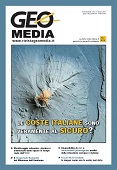Valutare l'erosione del suolo mediante l'applicazione del modello RUSLE in ambiente GIS
Parole chiave:
modello RUSLE, modello USLE, GISAbstract
Predicting GIS erosion by the application of RUSLE model in a GIS environment
The increase in soil erosion risk due to the current climate change is a focal point in sustainable land management. Being able to predict this risk is fundamental for impact mitigation and soil resource conservation. The state-of-the-art in geo-information technologies (GIS, remote sensing and image analysis) allows to perform, in semi-automatic way, assessments and predictions based on the integration of theoretical models with advanced techniques of geospatial and geostatistical analysis. One of the most successful models worldwide utilised, such as the Revised Universal Soil Loss Equation (RUSLE), can be now easily applied at multiple spatial and temporal scales, i.e. from the single catchment up to the regional scale and from interannual to long-term scenarios, by using GIS-based tools.
Riferimenti bibliografici
Bagarello V., Di Stefano C., Ferro V. (2008). I fattori topografici della USLE e la carta dell'erosione massima, in: Linee guida per l'applicazione della Universal Soil Loss Equation (USLE) in ambiente mediterraneo. Quaderni di Idronomia Montana, 28/1 (a cura di Vito Ferro), Nuova Editoriale Bios, Castrolibero (Cs), p. 231.
• Bagarello e Ferro (2008), Valutazione del fattore colturale per le coperture agrarie. In: Linee guida per l'applicazione della Universal Soil Loss Equation (USLE) in ambiente mediterraneo. Quaderni di Idronomia Montana, 28/1 (a cura di Vito Ferro), Nuova Editoriale Bios, Castrolibero (Cs), p. 231.
• Fierotti G., Dazzi C., Raimondi S. (1988), Carta dei suoli della Sicilia, Regione Sicilia, Assessorato Territorio e Ambiente, Palermo.
• Bagarello V., Dazzi C., Ferro V., Fierotti G., Giordano G., Santoro M. (1992), Indagine sull'erosione idrica potenziale del bacino del fiume Belice (Evaluating potential erosion in the Belice wateshed), Boll. A.I.C., n. 86, p. 105-110.
• Fierotti G., Dazzi C., Lombardo V. (1996), Sensibilità dei suoli all'erosione (Soils sensitivity to erosion), Agricoltura Ricerca n. 164-165-166: 25-32.
• Grauso S., Lo Curzio S., Pollino M. (2007), Previsione dell'erosione del suolo in funzione di cambiamenti climatici mediante il modello RUSLE, Conferenza Nazionale sui Cambiamenti Climatici, Workshop "Cambiamenti climatici e dissesto idrogeologico: scenari futuri per un programma nazionale di adattamento” sessione poster, Napoli, 9-10 luglio 2007.
• Grauso S., Diodato N., Verrubbi V. (2009), Calibrating a Rainfall Erosivity assessment model at regional scale in Mediterranean area, Environmental Earth Sciences. DOI: 10.1007/s12665-009-0294-z.
• Grimm M., Jones R.J.A., Rusco E. & Montanarella L. (2003), Soil Erosion Risk in Italy: a revised USLE approach, European Commission, JRC Space Applications Institute, European Soil Bureau, EUR 20677 EN.
• Hickey R., Smith A. and Jankowski P. (1994), Slope length calculations from a DEM within ARC/INFO GRID: Computers, Environment and Urban Systems, v. 18, no. 5, pp. 365 - 380.
• Hickey R. (2000), Slope Angle and Slope Length Solutions for GIS, Cartography, v. 29/1: 1 - 8.
• Kirkby M.J., Jones R.J., Irvine B., Gobin A., Govers G., Cerdan O., Van Rompaey A.J., Le Bissonnais Y., Daroussin J., King D., Montanarella L., Grimm M., Vieillefont V., Puigdefabregas J., Boer M., Kosmas C., Yassoglou N., Tsara M., Mantel S., Van Lynden G.J. and Huting J. (2004), Pan-European Soil Erosion Risk Assessment: The Pesera Map, European Commission, JRC Institute for Environment and Sustainabilty. EUR 21176 EN.
• Renard K.G., Foster G.R., Weesies G.A., McCool D.K., Yoder D.C. (1997), Predicting soil erosion by water. A guide to conservation planning with the revised universal soil loss equation (RUSLE), United States Department of Agriculture, Agricultural Research Service (USDA-ARS) Handbook no. 703. United States Government Printing Office, Washington, DC.
• Van der Knijff J.M., Jones R.J.A., Montanarella L. (1999), Soil Erosion Risk Assessment in Italy, European Commission, JRC Space Applications Institute, European Soil Bureau. EUR 19022EN.
• Van der Knijff, J.M., Jones, R.J.A., Montanarella, L. (2000), Soil Erosion Risk Assessment in Europe, EUR 19044 EN. European Soil Bureau.
• Van Remortel, R., Hamilton M. and Hickey R. (2001), Estimating the LS factor for RUSLE through iterative slope length processing of digital elevation data, Cartography, v. 30, no. 1: 27-35.
• Van Remortel R.D., Maichle R.W., Hickey R.J. (2004), Computing the LS factor for the Revised Universal Soil Loss Equation through array-basedslope processing of digital elevation data using a C++ executable, Computers & Geosciences 30: 1043–1053.
• Wischmeier W.H., Smith D.D. (1978), Predicting rainfall erosion losses: a guide to conservation planning, United States Department of Agriculture–Handbook no. 537. United States Government Printing Office, Washington, DC.
##submission.downloads##
Pubblicato
Come citare
Fascicolo
Sezione
Licenza
Gli autori che pubblicano su questa rivista accettano le seguenti condizioni:- Gli autori mantengono i diritti sulla loro opera e cedono alla rivista il diritto di prima pubblicazione dell'opera, contemporaneamente licenziata sotto una Licenza Creative Commons - Attribuzione che permette ad altri di condividere l'opera indicando la paternità intellettuale e la prima pubblicazione su questa rivista.
- Gli autori possono aderire ad altri accordi di licenza non esclusiva per la distribuzione della versione dell'opera pubblicata (es. depositarla in un archivio istituzionale o pubblicarla in una monografia), a patto di indicare che la prima pubblicazione è avvenuta su questa rivista.
- Gli autori possono diffondere la loro opera online (es. in repository istituzionali o nel loro sito web) prima e durante il processo di submission, poiché può portare a scambi produttivi e aumentare le citazioni dell'opera pubblicata (Vedi The Effect of Open Access).





